Page 401 of 527
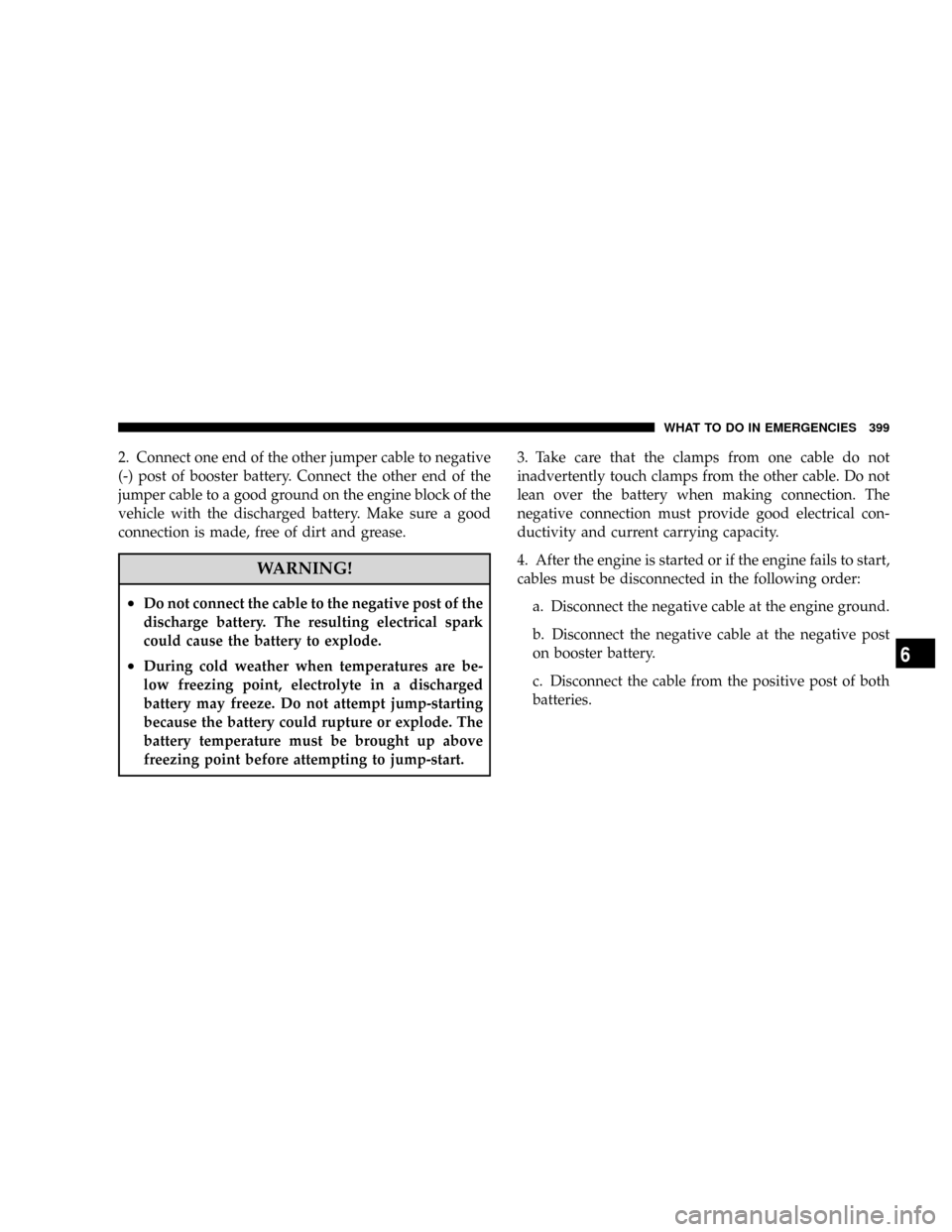
2. Connect one end of the other jumper cable to negative
(-) post of booster battery. Connect the other end of the
jumper cable to a good ground on the engine block of the
vehicle with the discharged battery. Make sure a good
connection is made, free of dirt and grease.
WARNING!
²Do not connect the cable to the negative post of the
discharge battery. The resulting electrical spark
could cause the battery to explode.
²During cold weather when temperatures are be-
low freezing point, electrolyte in a discharged
battery may freeze. Do not attempt jump-starting
because the battery could rupture or explode. The
battery temperature must be brought up above
freezing point before attempting to jump-start.3. Take care that the clamps from one cable do not
inadvertently touch clamps from the other cable. Do not
lean over the battery when making connection. The
negative connection must provide good electrical con-
ductivity and current carrying capacity.
4. After the engine is started or if the engine fails to start,
cables must be disconnected in the following order:
a. Disconnect the negative cable at the engine ground.
b. Disconnect the negative cable at the negative post
on booster battery.
c. Disconnect the cable from the positive post of both
batteries.
WHAT TO DO IN EMERGENCIES 399
6
Page 402 of 527
WARNING!
Any procedure other than above could result in:
1. Personal injury caused by electrolyte squirting out
the battery vent;
2. Personal injury or property damage due to battery
explosion;
3. Damage to charging system of booster vehicle or
of immobilized vehicle.
With Portable Starting Unit
There are many types of these units available. Follow the
manufacturer's instructions for necessary precautions
and operation.
CAUTION!
It is very important that the starting unit operating
voltage does not exceed 12-Volts DC or damage to
battery, starter motor, alternator, or electrical system
may occur.
FREEING A STUCK VEHICLE
If the vehicle becomes stuck in snow, sand, or mud, it can
often be moved by a rocking motion. Move the gear
selector rhythmically between DRIVE and REVERSE
(automatic transmissions) or between 1st and REVERSE
(manual transmissions), while applying slight pressure to
the accelerator.
400 WHAT TO DO IN EMERGENCIES
Page 403 of 527
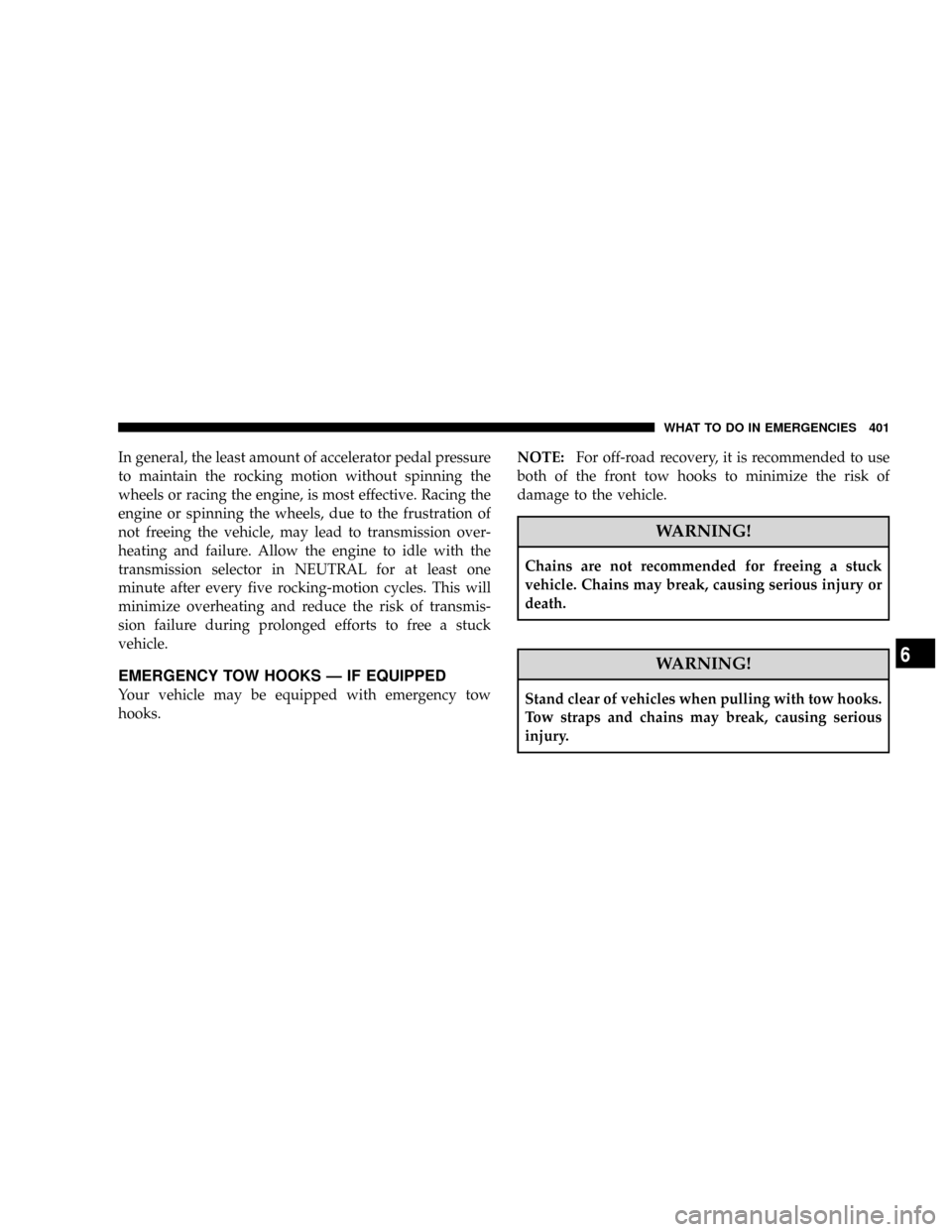
In general, the least amount of accelerator pedal pressure
to maintain the rocking motion without spinning the
wheels or racing the engine, is most effective. Racing the
engine or spinning the wheels, due to the frustration of
not freeing the vehicle, may lead to transmission over-
heating and failure. Allow the engine to idle with the
transmission selector in NEUTRAL for at least one
minute after every five rocking-motion cycles. This will
minimize overheating and reduce the risk of transmis-
sion failure during prolonged efforts to free a stuck
vehicle.
EMERGENCY TOW HOOKS Ð IF EQUIPPED
Your vehicle may be equipped with emergency tow
hooks.NOTE:For off-road recovery, it is recommended to use
both of the front tow hooks to minimize the risk of
damage to the vehicle.
WARNING!
Chains are not recommended for freeing a stuck
vehicle. Chains may break, causing serious injury or
death.
WARNING!
Stand clear of vehicles when pulling with tow hooks.
Tow straps and chains may break, causing serious
injury.
WHAT TO DO IN EMERGENCIES 401
6
Page 412 of 527
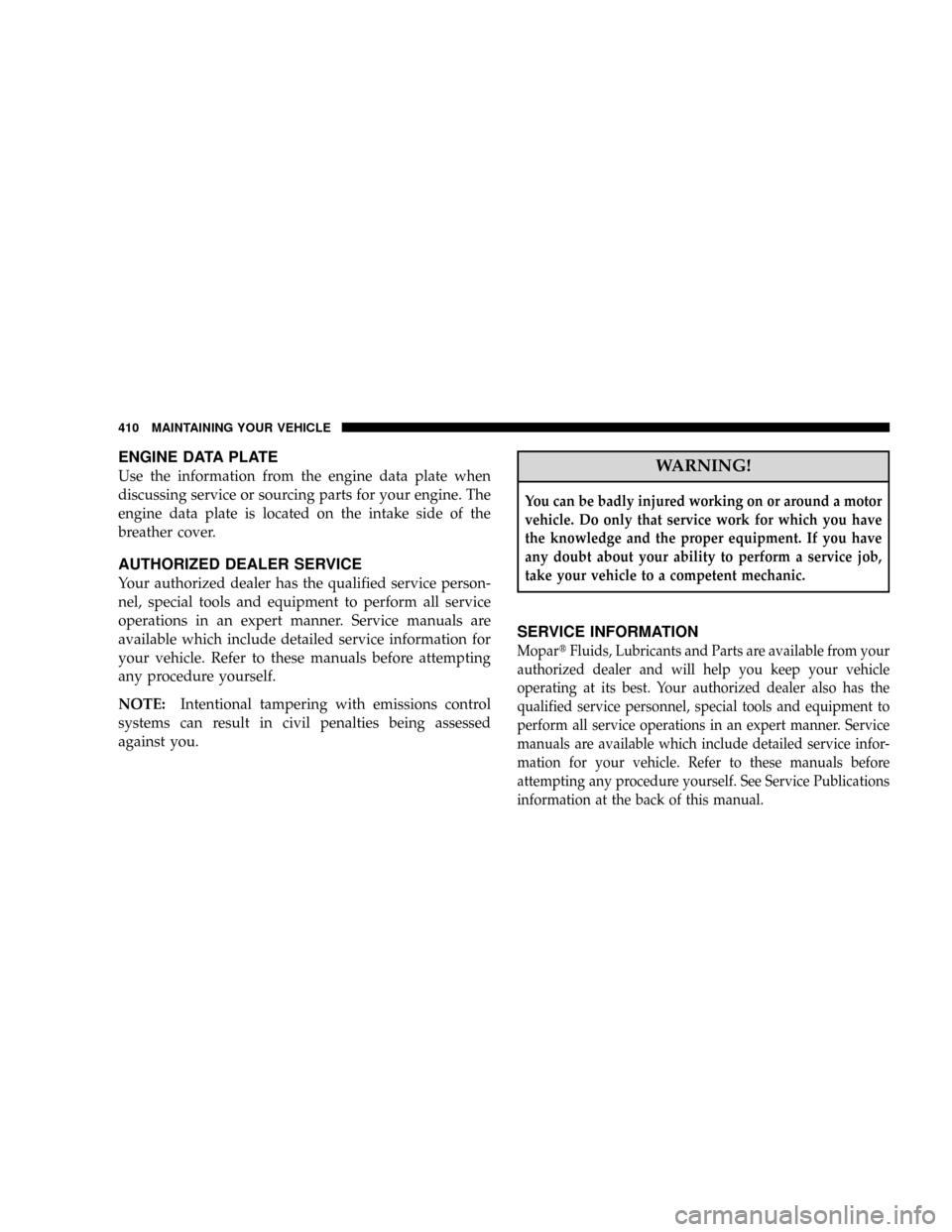
ENGINE DATA PLATE
Use the information from the engine data plate when
discussing service or sourcing parts for your engine. The
engine data plate is located on the intake side of the
breather cover.
AUTHORIZED DEALER SERVICE
Your authorized dealer has the qualified service person-
nel, special tools and equipment to perform all service
operations in an expert manner. Service manuals are
available which include detailed service information for
your vehicle. Refer to these manuals before attempting
any procedure yourself.
NOTE:Intentional tampering with emissions control
systems can result in civil penalties being assessed
against you.
WARNING!
You can be badly injured working on or around a motor
vehicle. Do only that service work for which you have
the knowledge and the proper equipment. If you have
any doubt about your ability to perform a service job,
take your vehicle to a competent mechanic.
SERVICE INFORMATION
MopartFluids, Lubricants and Parts are available from your
authorized dealer and will help you keep your vehicle
operating at its best. Your authorized dealer also has the
qualified service personnel, special tools and equipment to
perform all service operations in an expert manner. Service
manuals are available which include detailed service infor-
mation for your vehicle. Refer to these manuals before
attempting any procedure yourself. See Service Publications
information at the back of this manual.
410 MAINTAINING YOUR VEHICLE
Page 414 of 527
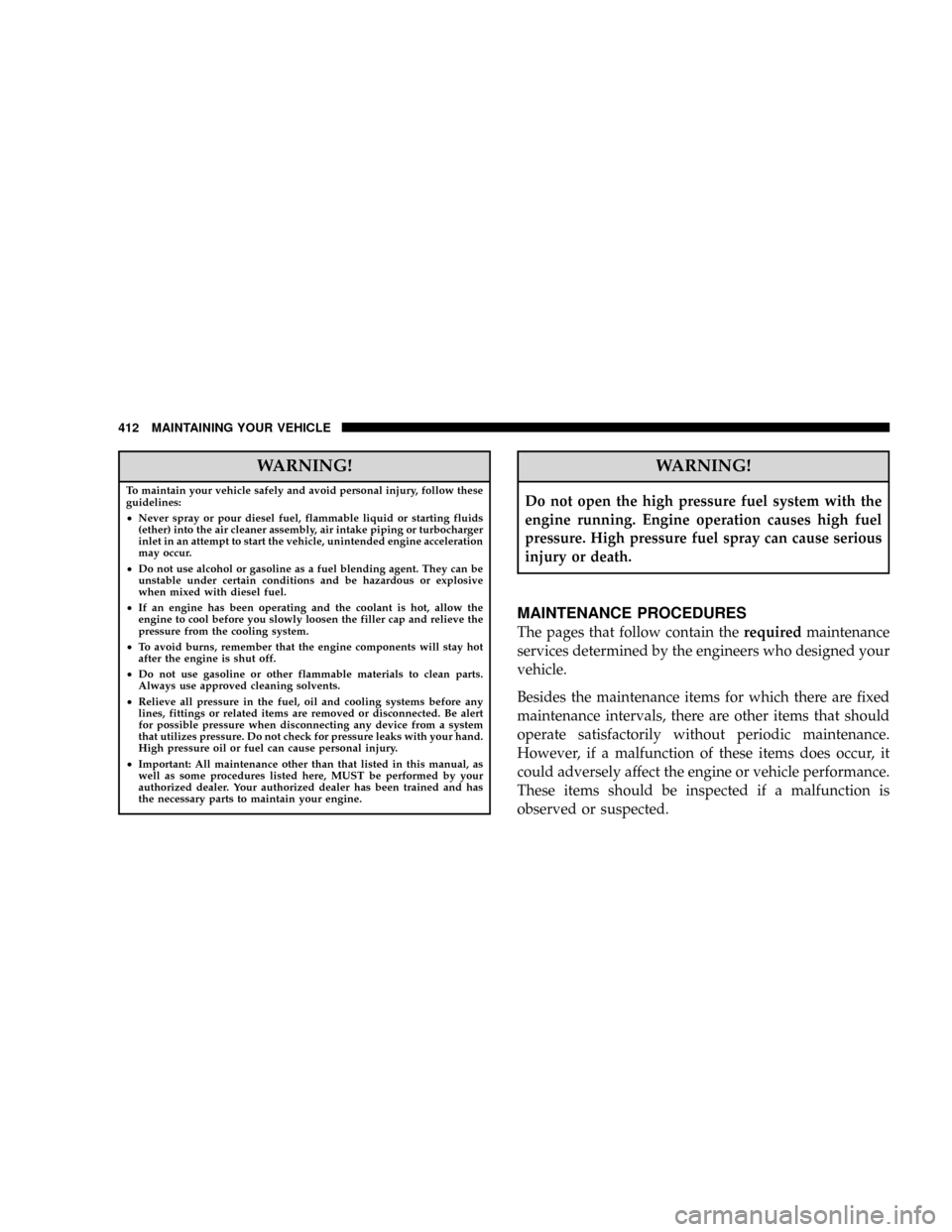
WARNING!
To maintain your vehicle safely and avoid personal injury, follow these
guidelines:
²Never spray or pour diesel fuel, flammable liquid or starting fluids
(ether) into the air cleaner assembly, air intake piping or turbocharger
inlet in an attempt to start the vehicle, unintended engine acceleration
may occur.
²Do not use alcohol or gasoline as a fuel blending agent. They can be
unstable under certain conditions and be hazardous or explosive
when mixed with diesel fuel.
²If an engine has been operating and the coolant is hot, allow the
engine to cool before you slowly loosen the filler cap and relieve the
pressure from the cooling system.
²To avoid burns, remember that the engine components will stay hot
after the engine is shut off.
²Do not use gasoline or other flammable materials to clean parts.
Always use approved cleaning solvents.
²Relieve all pressure in the fuel, oil and cooling systems before any
lines, fittings or related items are removed or disconnected. Be alert
for possible pressure when disconnecting any device from a system
that utilizes pressure. Do not check for pressure leaks with your hand.
High pressure oil or fuel can cause personal injury.
²Important: All maintenance other than that listed in this manual, as
well as some procedures listed here, MUST be performed by your
authorized dealer. Your authorized dealer has been trained and has
the necessary parts to maintain your engine.
WARNING!
Do not open the high pressure fuel system with the
engine running. Engine operation causes high fuel
pressure. High pressure fuel spray can cause serious
injury or death.
MAINTENANCE PROCEDURES
The pages that follow contain therequiredmaintenance
services determined by the engineers who designed your
vehicle.
Besides the maintenance items for which there are fixed
maintenance intervals, there are other items that should
operate satisfactorily without periodic maintenance.
However, if a malfunction of these items does occur, it
could adversely affect the engine or vehicle performance.
These items should be inspected if a malfunction is
observed or suspected.
412 MAINTAINING YOUR VEHICLE
Page 426 of 527
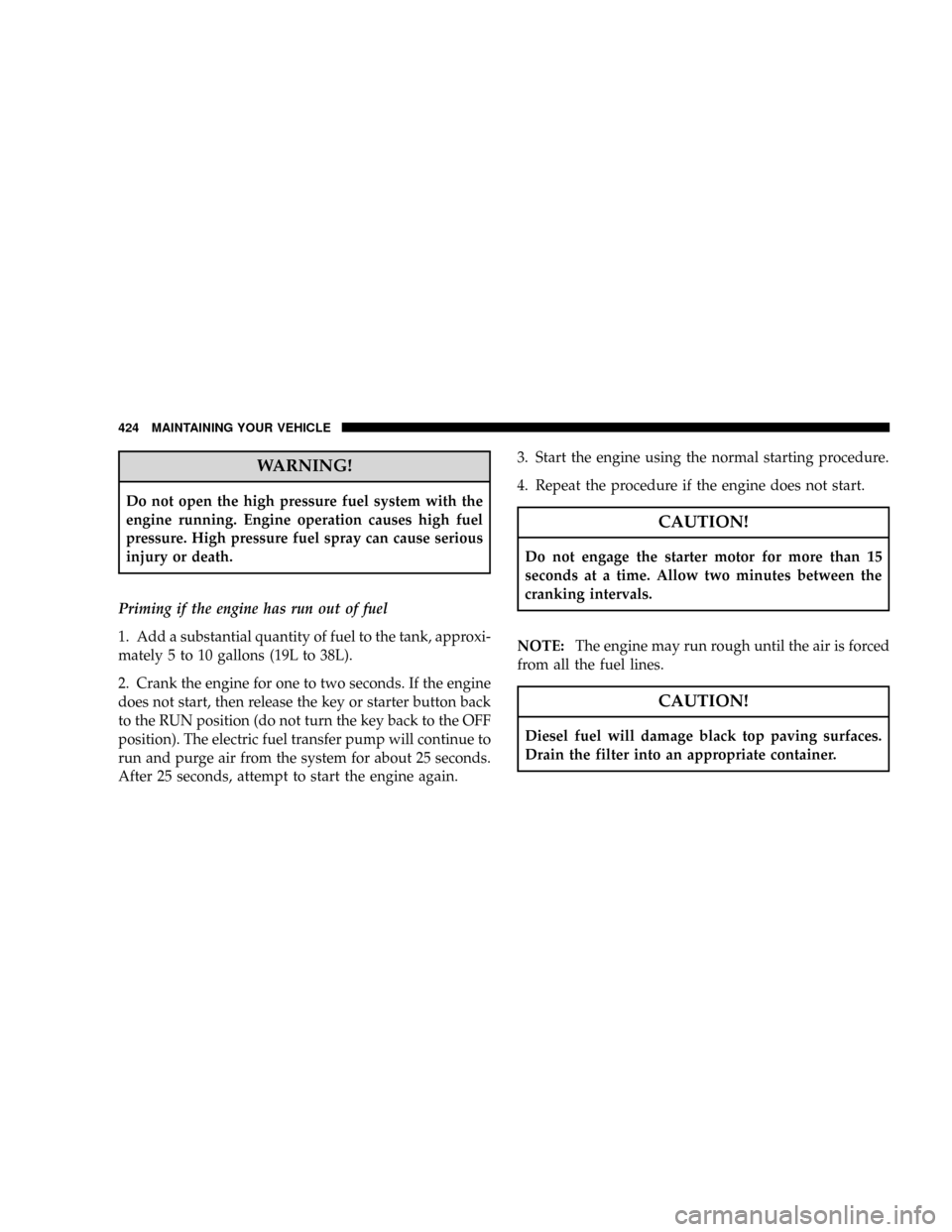
WARNING!
Do not open the high pressure fuel system with the
engine running. Engine operation causes high fuel
pressure. High pressure fuel spray can cause serious
injury or death.
Priming if the engine has run out of fuel
1. Add a substantial quantity of fuel to the tank, approxi-
mately 5 to 10 gallons (19L to 38L).
2. Crank the engine for one to two seconds. If the engine
does not start, then release the key or starter button back
to the RUN position (do not turn the key back to the OFF
position). The electric fuel transfer pump will continue to
run and purge air from the system for about 25 seconds.
After 25 seconds, attempt to start the engine again.3. Start the engine using the normal starting procedure.
4. Repeat the procedure if the engine does not start.
CAUTION!
Do not engage the starter motor for more than 15
seconds at a time. Allow two minutes between the
cranking intervals.
NOTE:The engine may run rough until the air is forced
from all the fuel lines.
CAUTION!
Diesel fuel will damage black top paving surfaces.
Drain the filter into an appropriate container.
424 MAINTAINING YOUR VEHICLE
Page 427 of 527
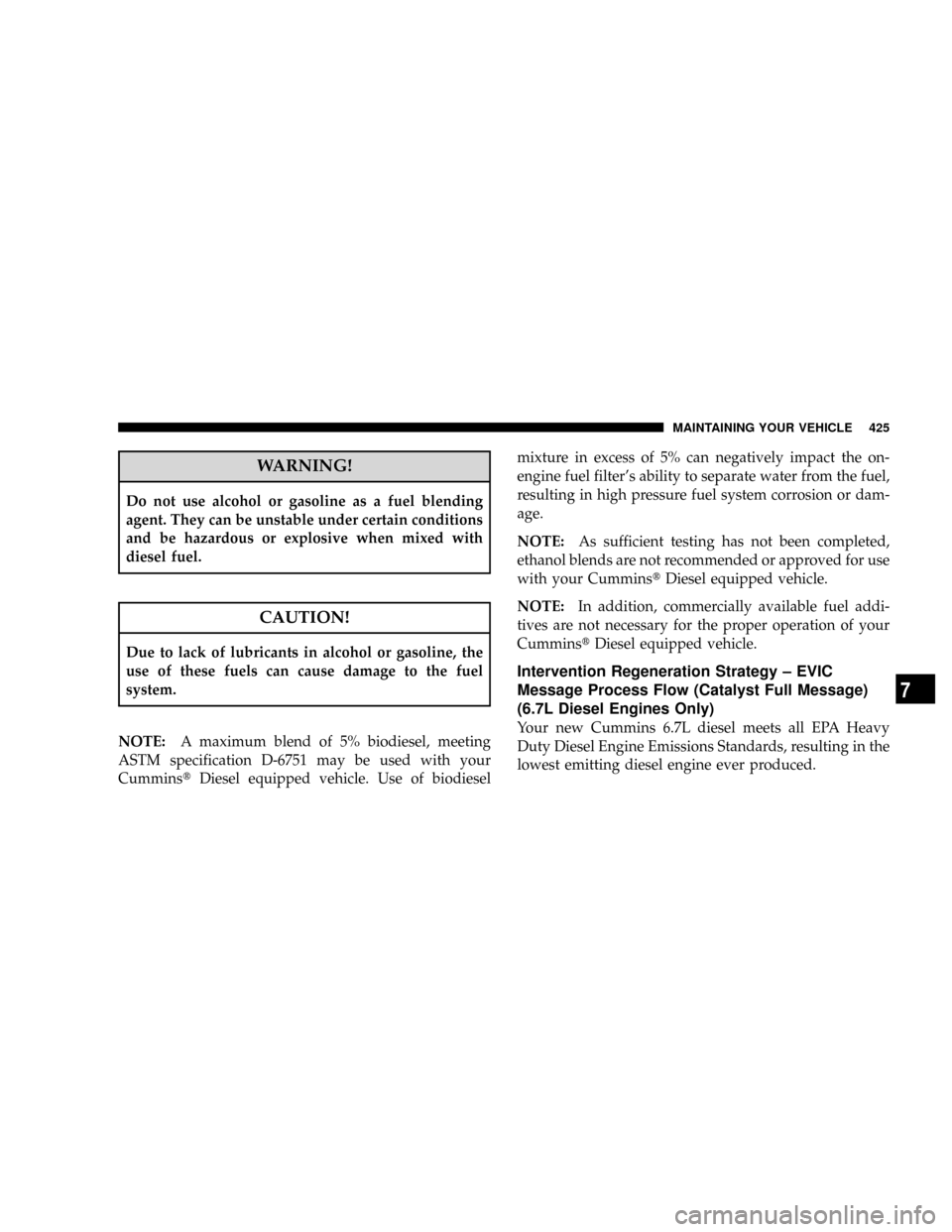
WARNING!
Do not use alcohol or gasoline as a fuel blending
agent. They can be unstable under certain conditions
and be hazardous or explosive when mixed with
diesel fuel.
CAUTION!
Due to lack of lubricants in alcohol or gasoline, the
use of these fuels can cause damage to the fuel
system.
NOTE:A maximum blend of 5% biodiesel, meeting
ASTM specification D-6751 may be used with your
CumminstDiesel equipped vehicle. Use of biodieselmixture in excess of 5% can negatively impact the on-
engine fuel filter's ability to separate water from the fuel,
resulting in high pressure fuel system corrosion or dam-
age.
NOTE:As sufficient testing has not been completed,
ethanol blends are not recommended or approved for use
with your CumminstDiesel equipped vehicle.
NOTE:In addition, commercially available fuel addi-
tives are not necessary for the proper operation of your
CumminstDiesel equipped vehicle.
Intervention Regeneration Strategy ± EVIC
Message Process Flow (Catalyst Full Message)
(6.7L Diesel Engines Only)
Your new Cummins 6.7L diesel meets all EPA Heavy
Duty Diesel Engine Emissions Standards, resulting in the
lowest emitting diesel engine ever produced.
MAINTAINING YOUR VEHICLE 425
7
Page 428 of 527
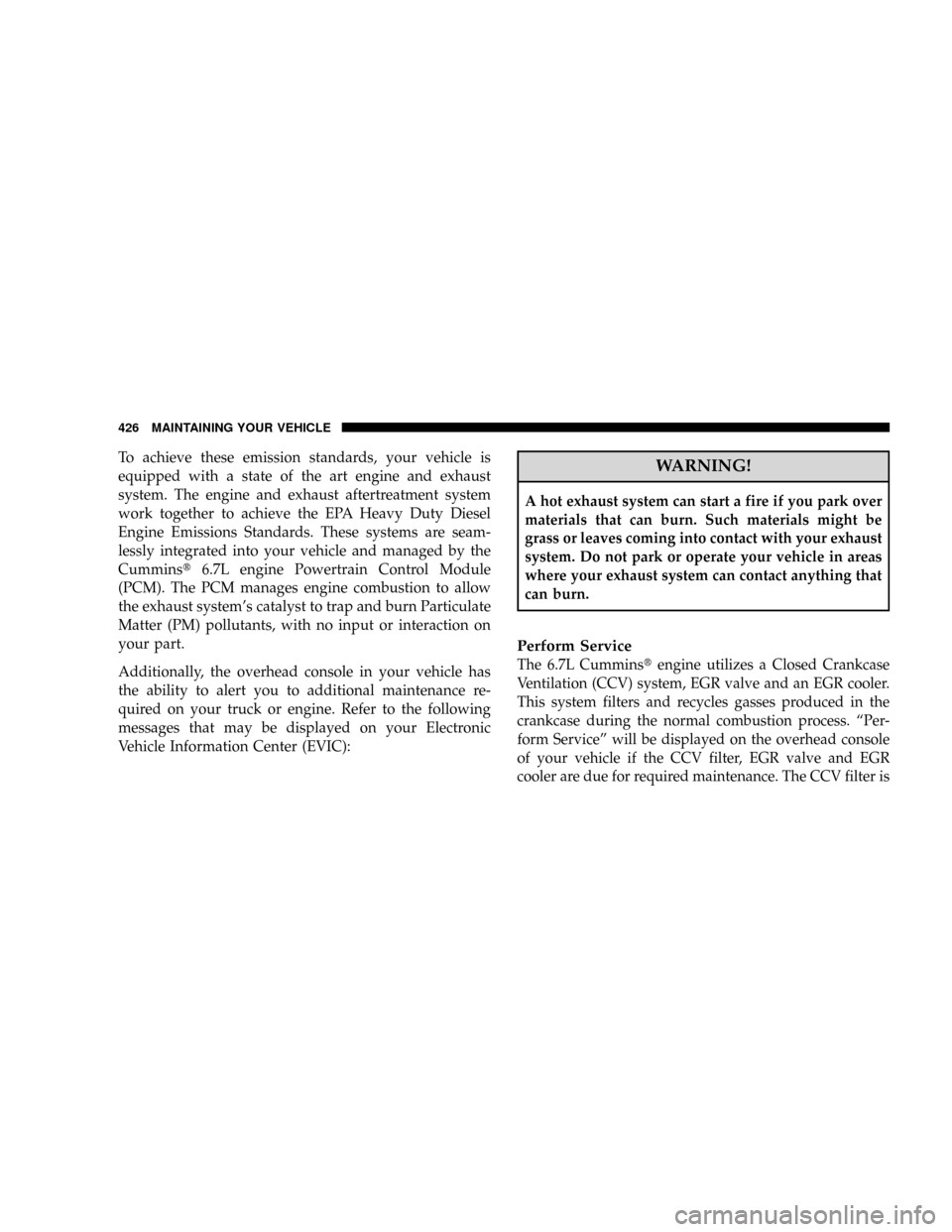
To achieve these emission standards, your vehicle is
equipped with a state of the art engine and exhaust
system. The engine and exhaust aftertreatment system
work together to achieve the EPA Heavy Duty Diesel
Engine Emissions Standards. These systems are seam-
lessly integrated into your vehicle and managed by the
Cumminst6.7L engine Powertrain Control Module
(PCM). The PCM manages engine combustion to allow
the exhaust system's catalyst to trap and burn Particulate
Matter (PM) pollutants, with no input or interaction on
your part.
Additionally, the overhead console in your vehicle has
the ability to alert you to additional maintenance re-
quired on your truck or engine. Refer to the following
messages that may be displayed on your Electronic
Vehicle Information Center (EVIC):WARNING!
A hot exhaust system can start a fire if you park over
materials that can burn. Such materials might be
grass or leaves coming into contact with your exhaust
system. Do not park or operate your vehicle in areas
where your exhaust system can contact anything that
can burn.
Perform Service
The 6.7L Cumminstengine utilizes a Closed Crankcase
Ventilation (CCV) system, EGR valve and an EGR cooler.
This system filters and recycles gasses produced in the
crankcase during the normal combustion process. ªPer-
form Serviceº will be displayed on the overhead console
of your vehicle if the CCV filter, EGR valve and EGR
cooler are due for required maintenance. The CCV filter is
426 MAINTAINING YOUR VEHICLE